Fujifilm X100VI Review
Fujifilm X100VI Introduction
The Fujifilm X100VI is a premium fixed-lens digital camera with a large APS-C CMOS sensor and a specially designed Fujinon 23mm F/2 prime lens, equivalent to 35mm on a full-frame camera. This moderately compact camera is built upon the latest X-Trans CMOS 5 HR sensor which sports 40 megapixels of resolution, the highest for any APS-C camera. X-Trans sensors uses a unique arrangement of color-filters to avoid moire even in the absence of an anti-alias filter to maximize captured detail.
For the first time in the X100-series, Fujifilm mounted the imaging sensor on a 5-axis image-stabilization mechanism. This new system can compensate for up to 6-stops of shake. Considering the effective 35mm focal-length, this IBIS is expected to handle exposures down to two seconds. This is incredible and further down its practical efficiency will be measured.
Inside its 23mm prime lens, a builtin leaf-shutter allows the X100VI sync with flash at high-speed. Extra flexibility is provided by a built-in 4-stop ND filter A hybrid-shutter allows ultra-short exposures down to 1/180,000s, the fastest possible by any camera. Using this electronic-shutter, the X100VI can capture images with a 1.25X-crop at 20 FPS, while the mechanical shutter reaches 6 FPS.
An incredibly sophisticated Hybrid-Viewfinder provides both a modern digital camera and rangefinder experience by switching between EVF and OVF modes. This viewfinder offers plenty of overlay and Focus-Assist modes, including a Picture-In-Picture view that shows the EVF image within the OVF area. A builtin Eye-Start Sensor automatically enables the chosen viewfinder mode.
The design of the Fujifilm X100VI follows analog rangefinders with direct dials to control exposure and an extremely sturdy rectangular metal construction. Automatic, semi-automatic and manual operations are all possible with this digital camera.
This digital camera review analyzes the Fujifilm X100VI in terms of features, ergonomics, usability, image-quality and performance.
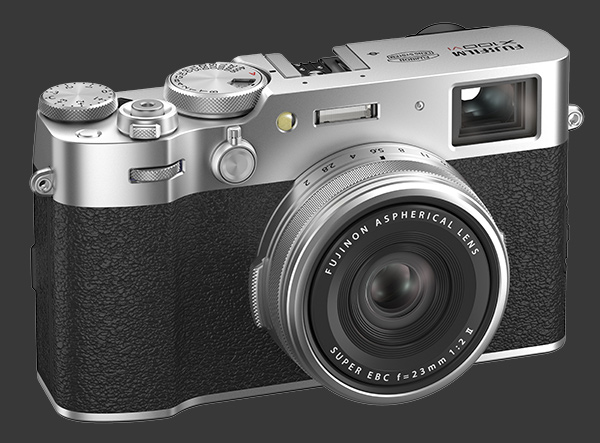
Fujifilm X100VI Features
Sensor
- 40 Megapixels CMOS sensor
- X-Trans 6x6 Color-Filter Array
- No Anti-Alias filter
- 1.5X Crop factor (APS-C)
- 3:2 Aspect ratio
- Image Stabilization
- 5-Axis
- 6-Stop Efficiency
- Dual IS Mode
- 100%, 200% or 400% Dynamic-Range
- Dynamic-Range Priority mode, 2 levels
- Sensor Dust Shake
Lens
- Fujinon 23mm prime lens, equivalent to 35mm
- Bright F/2 maximum aperture, 9-blade iris
- F/2 - F/16 Aperture range, 1/3 EV steps
- 10cm Minimum focus distance
- Leaf-Shutter
- Depth-Of-Field preview
- Optional builtin 4-Stop ND-Filter
Exposure
- ISO 125-12800 sensitivity range, 1/3 EV steps
- Expanded ISO 64-100, 25600 and 51200
- Auto ISO, selectable 400-12800 maximum
- ISO Bracketing, 3 frames, 1/3-1 EV steps
- Hybrid Shutter:
- Mechanical: 1/4000s-15m
- Electronic: 1/180000-15m
- Bulb exposure, maximum 1 hour
- Shutter-Speed Steps: 1/3 EV
- PASM Exposure modes, plus Bulb
- Multi-Segment, Center-Weighed, Spot & Average metering
- Exposure-Compensation, ±5, 1/3 EV increments
- Flash-Compensation, ±2, 1/3 EV increments
- Dynamic-Range Bracketing, 100-400%
- AEB, 9 frames, 1/3-3 EV increments
- ISO Bracketing, ±1 EV, 1/3 steps
- Multiple Exposure, 2-9 frames
- Fixed 1/3 EV exposure steps
Images Parameters
- Auto, 7 presetsSunny, Shade, 3 Fluorescents, Incandescent, Underwater, Kelvin and Custom WB
- WB fine-tuning along 2 axis in 19 steps
- WB Bracketing, 3 frames, 3 step sizes
- Film Simulation: Provia, Velvia, Astia, Classic Chrome, Reala Ace, Pro Negative Hi, Pro Negative Standard, Classic Negative, Nostalgic Negative, Eterna, Eterna Bleach Bypass, Acros, B&W, Sepia
- Film Simulation Bracketing, 3 frames
- Adjustable Color, Sharpness and High ISO Noise Reduction, 9 steps each
- Adjustable Highlight Tone and Shadow Tone, 13 steps each
- Adjustable Clarity 11 steps
- Optional Chrome Color Effect, 2 levels
- Optional Chrome Color Blue Effect, 2 levels
- Optional Long-Shutter Noise Reduction
- Optional Grain Effect, 2 levels x 2 grain sizes
- JPEG, HEIF, RAW, JPEG+RAW or HEIF+RAW Output
Drive
- Full-Resolution Continuous:
- 13 FPS, Max 80 JPEG or 24 RAW
- 6 FPS, Max 97 JPEG or 23 RAW
- 24 Megapixels 1.3X Crop Continuous Drive:
- 20 FPS, 117 JPEG or 35 RAW
- 13 FPS, 146 JPEG or 3617 RAW
- Blackout Free, 125% Coverage Preview
- 2s & 10s Self-Timers
- Interval Timer, 1s-24h interval, 1-999 frames, 0m-24h delay
- Motion Panorama, 180° & 120° angle-of-view
Focus
- Single-Shot or Continuous AF mode
- Single-Point, Zone or Wide AF selection
- Fine-Tunable Tracking AF-C:
- Tracking Sensitivity, 5 levels
- Speed Tracking, 3 levels
- Zone Switching, Auto, Center or Front
- Manual-focus (MF), Electronic Magnification
- Hybrid 425-Point Phase-Detect AF system
- Focus Bracketing, 2-999 Frames, 10 Step sizes, 0-10s Interval
- Optional DMF mode
- Optional Pre-AF
- Optional Digital Split Image
- Optional Digital Microprism
- Optional Focus Peaking
- Optional AF-Assist lamp
- Optional Face and Eye Tracking, 4 modes
Video
- 6240x3150 6K @ 30 FPS
- Cinema 4K and 4K Ultra HD @ 60 FPS
- Full HD and Cinema HD @ 240 FPS Video
- MPEG-4 or Quicktime H.265
- Built-in Stereo Microphone
- Stereo Audio Input 2.5mm micro-jack
- Stereo Audio Output via USB-C adapter
- Timecode Controls
Viewfinder & Displays
- Unique Hybrid Viewfinder:
- 3.7 Megapixels 0.5" EVF: 0.66X Magnification, 100% Coverage
- Reverse Galilean OVF: 0.52X Magnification, Over 100% coverage, Framing Guide at 95%
- EVF Overlay in OVF mode
- Eye-Start Sensor
- 3" Tilting Touchscreen LCD:
- 1.6 Megapixel
- 100% Coverage
- 3:2 Aspect-Ratio
- Digital-Level, 1 axis, tilt only
- Manual-Focus and Depth-Of-Field guide
- Optional Status-Display on rear LCD
- Optional HUD overlay on OVF
Controls
- Dual Clickable Control-Dials
- Direct 1/3-stop Aperture-ring, F/2-16
- Direct 1/3-stop ISO dial, ISO 125-12800
- Direct Full-Stop Shutter-Speed dial, 1/4000-1s
- Direct 1/3-stop ±3 Exposure-Compensation dial
- Implicit Exposure-Mode
- Combined configurable AE-L/AF-L button
- Customizable Function buttons
- Fly-By-Wire manual focus ring
Body & Construction
- Solid magnesium body
- Partially weatherproofRequires Optional AR-X00 Adapter-Ring and PRF-49 Protector Filter.
- Metal tripod mount
- Standard Hot-Shoe
- Builtin flash, 4.4 GN
- Wired-Remote terminal
- WiFi 802.11b/g/n
- Bluetooth 4.2 LE
- 4K HDMI output
- USB 3.1 Type-C connectivity
- SDXC UHS-I memory card slot
- Proprietary Lithium-Ion battery
Fujifilm X100VI Suitability - What is it good for?
The Fujifilm X100VI is an interesting and capable digital camera. With its full manual-controls, including bulb exposure, manual-focus and custom white-balance, the Fujifilm X100VI lets photographers be highly creative except for one crucial limitation: a fixed 23mm prime lens. This means that every photo from this digital camera shows exactly the same perspective.
The 23mm focal-length is equivalent to a 35mm lens on a full-frame camera, which is most often described as a slightly-wide normal lens. For years, an equivalent was bundled with film SLRs. This focal-length provides a versatile field-of-view that lets photographers shoot in moderately tight spaces without the look of a truly wide-angle lens. While everyone is free to point the Fujifilm X100VI at any subject, the perspective offered by its Fujinon lens is better suited for environmental portraits, social events, reportage and general snapshots. This forces the photographer to interact which can lead to better images by increasing awareness.
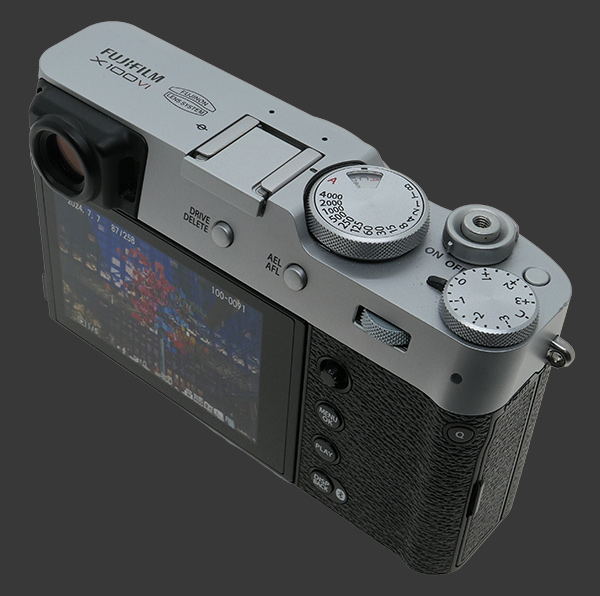
Beware that the 35mm-equivalent focal-length is certainly not ideal for wildlife, sports and architecture. Success of landscape photography is greatly dependent on location, more intimate vistas may work well but breathtaking ones absolutely require more effort to compensate for a fixed angle-of-view. Multiple images though can easily be stitched into a wide-angle panorama to increase the field-of-view. Actually, this camera can produce a low-resolution 180° panorama directly in-camera using its Motion Panorama mode.
Each generation of the X100 series increased the amount of features. This time the X100VI significantly expanded the shutter-speed range. With IBIS added, this latest model can capture much faster moving subjects and remain usable in low-light for much longer. This is great to do urban night photography and capturing dimly-lit environments.
Although not ideal for general action photography since the photographer must be rather close to his subjects when using the Fujifilm X100VI, this camera is well-equipped to capture fleeting moments. With 13 FPS continuous shooting and both OVF and EVF modes that shows more than 100% coverage, plus an ultra-fast 425-Point Phase-Detect AF system, this fixed-lens camera improves chances of capturing a precise moment.
Fujifilm X100VI Usability - How easy is it to use?
NOTE: Ergonomically, the Fujifilm X100VI is identical to the X100V. This review section is mostly identical to that of its predecessor.
Ergonomics of the X100VI give it a retro feel. The body of this digital camera is rather boxy with a slight bump on the front to serve as a grip but it provides almost no purchase. What adds security though is that the design of the X00V requires both hands to operate. An anachronistic shutter-release threaded for a mechanical remote cable is found flat on the top-plate. It is not the most comfortable yet is quite suitable.
The top-plate splits into two levels. The lower level, on the right side of the camera, has the shutter-release surrounded by a rotating power-switch. This switch is sufficiently stiff to avoid turning the camera on accidentally. A tiny button to the right of the shutter-release is an easily accessible function button that can be set to one of 57 functions! This is quite possibly the largest choice for a single button on any camera. Four other buttons can be customized, as the clickable action of the rear control-dial, described further below.
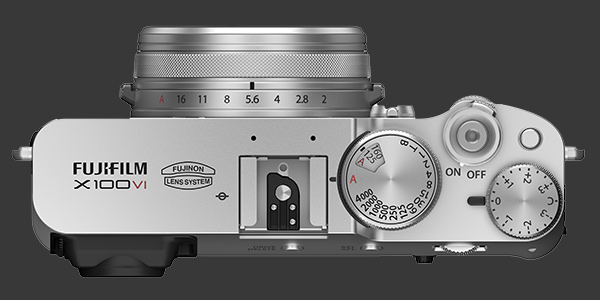
At the corner of the top-plate, the X100 has an Exposure-Compensation dial. This dial is marked ±3 in 1/3 EV steps with firm detents between positions. A special C position delegates EC to a control-dial which expands the range to ±5, always in 1/3-stops. The last dial on the top-plate is actually two dials nested to control both shutter-speed and sensitivity. The outer dial sets shutter-speed from 1/4000s to 1s in Full-Stops only. One can use a control-dial to shift ±2/3 EV or the special T position to set any shutter-speed from 1/180000s in Electronic-Shutter mode or 1/4000s in Mechanical-Shutter mode all the way until 15 minutes. The inner dial controls ISO. This one covers the entire Standard ISO sensitivity range in 1/3 stops. An extra C position allows a control-dial to select sensitivity from ISO 50 to 51200. An additional A position enables Auto ISO. The outer dial must be lifted to move the inner dial which shows its status in a small winder between A and B on the shutter-speed dial.
A dedicated aperture-ring around the lens barrel is visible from the top of the camera. This ring is narrow and really close to the body, so Fujifilm gave it tables to facilitate rotating it. Although the aperture-ring is marked in full-stops from F/2 to F/16, it has soft detents between every 1/3 steps. Ahead of the aperture-ring is a Control-Ring that rotates freely without hard stops or detents. It primarily serves to set the focus distance in MF and DMF modes but can also change White-Balance, Film-Simulation and Digital-Zoom. Unfortunately none of these extra options are well-suitable for a control without detents.
The Fujifilm X100VI clearly has more direct controls than the vast majority of fixed-lens cameras. It is also highly modal, meaning that most dials have marked positions. This makes the camera-state readable by simply looking, even when it is off. With the new C position on both the EC and ISO dial, plus T on the Shutter-Speed dial, the X100VI is remarkably efficient and notably improved from earlier generations.
Absent from the Fujifilm X100VI is an exposure mode-dial. With this camera, like the analog ones that inspired it, a photographer does not announce in advance which exposure parameters can be set. Instead, parameters are simply set to the desired value. If a parameter should be automatically controlled, then it is simply set to the A position. With these dials, this gives access to all standard Exposure-Modes:
| Exposure Mode | Aperture Ring | Shutter-Speed Dial | Primary Control-Dial | Optional Control-Dial |
|---|---|---|---|---|
| Program | A | A | Program-Shift | ISO / EC |
| Aperture-Priority | F/2 - F/16 | A | ISO / EC | |
| Shutter-Priority | A | 1/4000 - 1s | ±2/3 Shutter-Speed | ISO / EC |
| Shutter-Priority | A | T | 1/32000s-15m | ISO / EC |
| Manual | F/2 - F/16 | 1/4000 - 1/4 | ±2/3 Shutter-Speed | ISO / EC |
| Manual | F/2 - F/16 | T | 1/32000s-15m | ISO / EC |
| Manual | F/2 - F/16 | B | ISO / EC |
There is a tremendous amount of flexibility with this setup. Those who use Expanded ISO setting or find the nested ISO dial awkward, can simply assign the rear control-dial to ISO. This leaves the front control-dial mostly unused but could be set to EC to access the greater ±5 EV range than the EC dial offers.
Focus modes are set using a slider on the left side of the camera. It is small with very little movement, so it is possible to miss the middle setting and would be difficult to change while wearing gloves. The bottom position if AF-S, while the top is MF. The middle is for AF-C which is used for Face and Eye-Tracking features. One can click the rear control-dial to magnify the center of the frame to assist in focusing. The right side of the camera has a thin plastic door to cover a 2.5mm micro-jack, USB-C and Micro HDMI connectors.
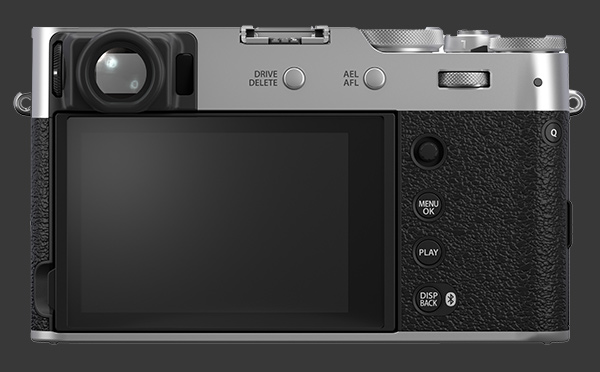
The back of the Fujifilm X100VI is more spacious than early models due to streamlined controls. The upper-left corner of this camera has the unique hybrid viewfinder. Being aligned on the edge of the camera makes looking into the viewfinder very comfortable, as you can bring your eye very close without pressing your nose against it. An Eye-Start Sensor to the right of the viewfinder automatically switches between the rear LCD and the last hybrid viewfinder mode.
The unique hybrid viewfinder is a technological marvel! It combines a modern 3.7 Megapixels 0.5" EVF having medium 0.66X magnification and 100% coverage with a Reverse Galilean Optical Viewfinder behind one lens. Just like an optical-tunnel, the OVF shows neither focus, nor exposure, nor framing accurately. . The view through the OVF shows considerably more than 100% while a frame within marks an area with 95% coverage but not the central portion due to the difference in alignment between the OVF and lens. Optical mode uses EVF components to show an amazing HUD unlike any OVF. It is even possible to overlay a portion of the EVF to show the focus-area near the lower-right corner.
Right below the hybrid viewfinder, a 3" Touchscreen LCD with 1.6 megapixels is mounted on a thin tilting hinge to frame at odd angles. This new display is extremely sharp but lacks an anti-reflective coating. It becomes difficult to see in bright light. The hybrid viewfinder is easier to see but part of the OVF view is clipped by the lens that can be seen in the lower-right corner. Only a small portion overlaps the 95% guide though. When no parameter is set to A, the preview is now Exposure-Priority when the Preview Exp In Manual Mode option is selected in the Setup menu. Otherwise, it still unfortunately shows the metered exposure, offset by EC, instead. Therefore, automatic and semi-automatic exposures are not always previewed correctly.
There are several button on the back of the X100VI. The only unfortunately-placed one is the Delete/Drive button that is found near the viewfinder. It is impossible to reach without shifting the position of one hand. A combined AE-L/AF-L button further right is customizable. The thumb lands between AE-L/AF-L and the rear control-dial. All remaining buttons are to the right of the LCD and accessible with the thumb, although lower ones are a stretch. The new Q button is minuscule and difficult to activate without looking at the camera since it is completely flush with the surrounding surface.
An 8-way joystick serves to move the focus-point or focus-area and also doubles as directional controller to navigate menus, similarly to most recent Fujifilm digital cameras. It is very responsive and quite efficient. Below it are pretty standard Menu/OK, Play and Disp/Back buttons. The joystick is clickable to center the focus area or select menu items which can also be done using the Menu button. When a menu is open, the Disp button serves to return to the previous level, which is often possible by moving the joystick to the left.
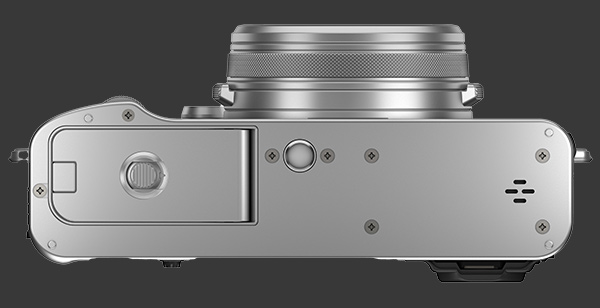
The bottom of the X100VI has a metal tripod mount which is neither inline with the lens nor the center of the camera. It is found very close to the combined battery and memory compartment. This makes it impossible to change batteries or memory cards while the camera is attached, even on a small QR-plate. The battery is almost symmetric which lets it be inserted the wrong way.
The X100VI is finally one of the most usable fixed-lens digital camera on the market. The rear control-dial has unfortunately too soft detents and frequently moves accidentally. All things considered, the position of the Delete button, flush Q button and fractional Shutter-Speed control are fairly minor issues. One still has to be careful with the preview is not always Exposure-Priority.
Fujifilm X100VI Performance - How well does it take pictures?
Fujifilm launched the X-Trans CMOS 5 HR sensor inside the X-H2 reviewed here
Fujifilm X-H2. This 40 megapixels APS-C imaging-sensor represents a huge jump in resolution compared to earlier generations. Only three cameras use this sensor, both already mentioned plus the excellent X-T5 reviewed here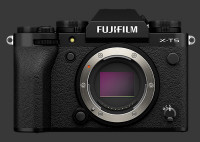
Fujifilm X-T5.
The new 40 Megapixels APS-C sensor in the Fujifilm X100VI has the highest resolution of any APS-C camera. This gives it the smallest pixel-pitch of any digital camera sensor, the equivalent of a hypothetical 100 MP Full-Frame sensor, even though sensors that size max out at 61 MP to date. With such tiny pixels, the noise level of this new sensor is truly impressive.
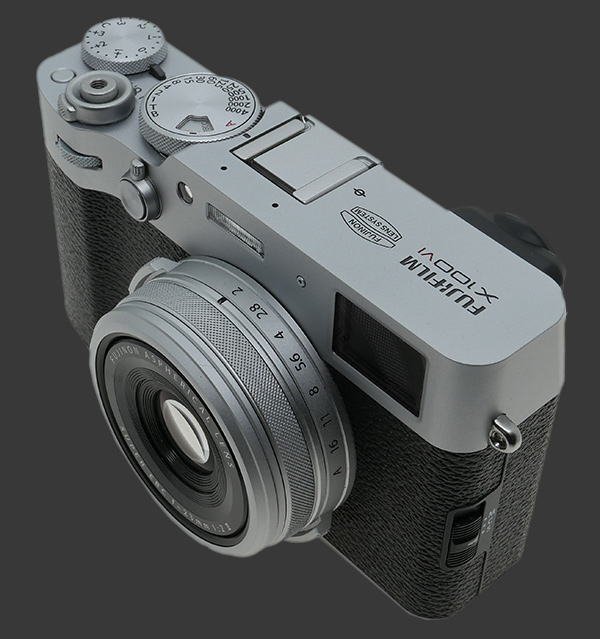
Image Noise & Details
Even though the 40 MP X-Trans CMOS 5 HR boasts a resolution 50% higher than the previous generation 26 MP X-Trans CMOS 4, it manages to match its extremely low noise from ISO 64 to 200. This performance makes it possible to make clean 30" x 20" prints, previously only possible using a Full-Frame or larger sensor! The X-Trans CMOS 5 HR sensor captures a tremendous amount of detail without being affected by moire.
At ISO 400, noise is absolutely minimal. It is just barely noticeable at 100% which still makes 30" x 20" prints look really good and 27" x 18" absolutely impeccable. So, while per-pixel noise is fractionally higher, this results in larger usable prints than 4th-generation sensors. Very fine details are rendered exceptionally well and contrast remains intact.
Image-noise starts becoming noticeable at ISO 800 when seen at full magnification. Its very fine noise pattern leaves fine detail virtually intact and only reduces maximum print sizes slightly. A large 24" x 16" print looks impeccable and stands up to close-inspection well. Contrast is unaffected by this little noise. At this ISO, the X100VI is capable of capturing 400% the base dynamic-range - an extra 2-stops - which lets it maintain deep blacks even in the presence of noise.
ISO 1600 looks a little noisy upon close inspection. The fine noise-pattern damages only the finest details but it remains barely visible at anything less than maximum size. One can easily make a beautiful large moderately large print at this sensitivity. Both image contrast and dynamic-range are maintained quite well, better than on the X-H2 which is more tuned for video.
Image quality takes a moderate drop at ISO 3200, although appreciably less than on the X-H2. Details become a little soft and edges get damaged by noise. Contrast is only a fractionally lower. Given a high 40 megapixels of resolution, it is possible to produce good mid-size prints up to 21" x 15". Colors stay very consistent and noise only affects the luminance channel.
The trend continues progressively up to ISO 6400. It brings another moderate loss of image-quality with details damaged by noise-reduction. At this point, the X100VI benefits from over a full stop lead over the X-H2. Expect reasonable mid-size prints of 18" x 12". These will not stand to close inspection but look fine at typical viewing distances. Impressively, contrast and dynamic-range are similar to ISO 3200.
The last standard sensitivity of ISO 12800 is clearly worse yet usable for small prints and scaled down for online use. Given its incredibly tiny pixels, this performance is better than expected. Noise is concentrated in the luminance channel with a reduction in dynamic range but remarkably accurate colors. It is possible to push sensitivity 2 more stops in the expanded range but only ISO 25600 remains usable for emergencies.
Sharpness can be controlled in 9 levels. The lowest -4 setting is extremely soft and the highest +4 is certainly over sharpened. The default setting of zero is on the soft side. By pushing sharpness to +1, images become much crisper without any artifacts. Note that on the X-H2, it was necessary to push Sharpness to +2 and its output was still softer! This only comes down to processing. Further improvement in image-quality can be obtained by reducing High ISO noise-reduction to -2. Keep in mind that these units are completely arbitrary.

Color & White Balance
Fujifilm color rendition is well-regarded and the X100VI certainly lives up to this expectation. Its color accuracy is excellent with realistic hues. Different Film Simulation modes mostly affect saturation and contrast in different ways. There is a huge selection of films, 14 base ones plus three filtering variants of two monochrome modes. Provia is still a great choice yet for the ultimate in color-accuracy, the new REALA ACE option is even better. With Color set to +1, rendition is very realistic.
There are 3 Automatic White-Balance modes on the Fujifilm X1000VI. The new White-Priority mode delivers neutral results under most conditions. It differs slightly in color temperature compared to standard AWB in the presence of artificial lighting. A third Ambiance AWB mode skews towards warm colors but very slightly, producing natural looking results with minimal effort from the photographer.
Under low-light, Automatic White-Balance modes, even the White Priority variant, starts leaving a yellow cast that gets more pronounced with artificial light sources. A WB Preset greatly improves the situation, while WB Fine-Tuning along 2-axis in 19 steps makes it possible to neutralize nearly any color-cast. Falling back to Custom White-Balance provides much more accurate colors in difficult situations.
Exposure & Dynamic-Range
The Multi-Segment metering system of the Fujifilm X100VI is extremely consistent and reliable. It is very conservative which makes it produce dark images, not underexposed though, when faced with low-contrast scenes. Otherwise, there exposure-compensation is rarely needed to avoid blowing large highlights.
Remember that in OVF mode, it is not possible to see exposure. The preview shown in the EVF is fairly but not always entirely accurate. Brighter subjects tend to be shown more accurately than low-light ones. Even with Exposure-Priority preview enabled, the X100VI only applies it to Manual exposure, so metering issues are not always visible until an image is reviewed.
Normally digital cameras with smaller pixels have a narrower dynamic range yet Fujifilm somehow managed to make the X100VI capture an very wide dynamic range at low sensitivities. Maximum dynamic range is achieved at ISO 800 which can reliably capture scenes with 14-stops of dynamic-range when the camera is configured to 400% DR. From ISO 200 and 400, a fraction less than 14-stops can be captured. ISO 100 and 64 are Expanded ISO sensitivities which clip dynamic-range to 13-stops.
This extremely impressive dynamic-range ends above ISO 800 when it gradually decreases by ½-stops for each full-stop of sensitivity. At ISO 12800 and beyond, the drop off becomes more pronounced and exceeds one stop between consecutive ISO because additional image noise fills up dark pixels. Just like other high-resolution cameras, the X100VI works better at low sensitivities where noise is low and dynamic-range is high.
The Fujifilm X100VI offers a Dynamic-Range Priority mode. This can be turned off or set to weak or strong levels. In this mode, Dynamic Range, Shadow Tone and Highlight Tone settings are locked out and the camera takes into account feedback from the sensor to optimize all those settings. Generally though, tuning Shadow Tone to -½ delivers good and consistent results.
For scenes that exceed the dynamic-range of the Fujifilm X100VI, the camera offers builtin HDR. Each HDR frame is made by capturing 3 frames with exposure varying by 1, 2, 3 or 4 stops. The result is merged in-camera with a short lag, about one second. There are 4 selectable levels: 200% DR, 400% DR, 800% and 800%+.
Clarity affects mid-tone contrast which provides the illusion of increased subject detail. Unfortunately, applying Clarity is resource intensive which introduces a notable camera lag at any Clarity setting other than the default of zero. This makes the X100VI feel sluggish. Images with Clarity set to +1 or 2 look great without seeming unnatural.
The new Fujinon 23mm F/2 lens surpasses the level of detail captured by the original even on a sensor of much higher resolution. The performance of this builtin lens is so impeccable that it captures perfect edge-to-edge sharpens from wide-open and until F/11, right before a hint of diffraction starts. It is not until F/16 that resolution is appreciatively lowered which is an incredible achievement.
Secondary optical issues are rare with this 23mm F/2 lens. There is no noticeable vignetting. A tiny level of pincushion distortion can be measured but is not visible in images. Chromatic aberrations are extremely well-controlled too. The lack of a lens hood makes the lens a little susceptible to flare when a bright light source appears within the frame. Such flare is well-managed and only appears as a bright spot rather than affecting images globally.
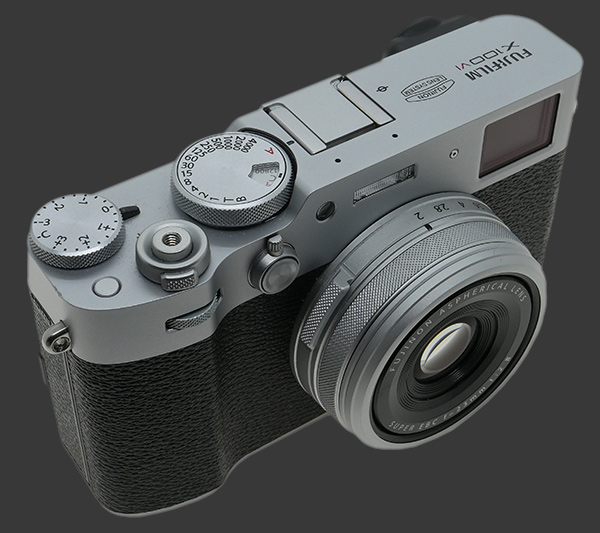
Auto Focus & Speed
A hybrid 425-Point Phase-Detect AF system is built right into the 40 Megapixels X-Trans CMOS 5 HR sensor. Phase-Detection elements cover nearly the entire sensor area and together are presented as a 425-point or 117-point system where each point has a variable size. Focus zones are created by grouping points together.
The autofocus system is quick and decisive. It can focus nearly instantly when the lens is already focused at a similar distance. When a large change in focus-distance is required, there is a small yet perceptible lag. This is due to the fixed lens which appears to have a slightly week focus motor.
Fujifilm equipped the X100VI with advanced continuous autofocus and subject tracking. It can manage to follow motion well when subject distance does not change much. However the lens is too slow to keep up with the tracking system when distance changes even moderately.
The X100VI is generally quite responsive. It responds instantly to any dial turn and button press. The Eye-Start Sensor is quite sensitive and switches instantly between the rear LCD and Hybrid-Viewfinder. There is a tiny delay when switching between EVF and OVF modes. Most camera functions happen very quickly, even more complex ones such as HDR and Bracketing. There is a normal yet short delay while performing Exposure-Fusion in HDR mode. Some heavier processing features, such as Clarity, cause short delay immediately after releasing the shutter.
The performance of the Fujifilm X100VI is characterized by the following numbers:
- Power On: 1s. Average.
- Power On to First-Shot: 2s. Average.
- Autofocus: Instant to ½s. Below average.
- Shutter-Lag: Instant blackout-free. Excellent.
- Shot-to-shot: 2/3s. Above average.
- Playback: Just over 1s to enter or exit. Average.
- Power-Off: 1¼s. Average.
The increase in resolution requires significantly more processing power. So, despite a new processor, performance of the Fujifilm X100VI remains similar to its predecessor. Shutter-lag is excellent yet autofocus is a little slower than average due to a weak focus motor. It is slow enough to introduce a noticeable lag but it is sufficient for slow moving subjects.
Continuous drive is fast with a maximum speed of 11 FPS. The buffer is not particularly deep and clearing it is very slow, even using a fast UHS-II card. This is about throughout. The camera must process 440 megapixels per second to sustain the maximum speed at full-resolution.
Battery life is quote at 310 shots-per-charge, a little lower than its predecessor but this number is more realistic. One really requires an extra battery or two for a full day of photography. There is an Economy mode that extends battery life by 20% but, considering the X100VI is not terribly fast, it could feel a little sluggish.
Fujifilm X100VI Conclusion
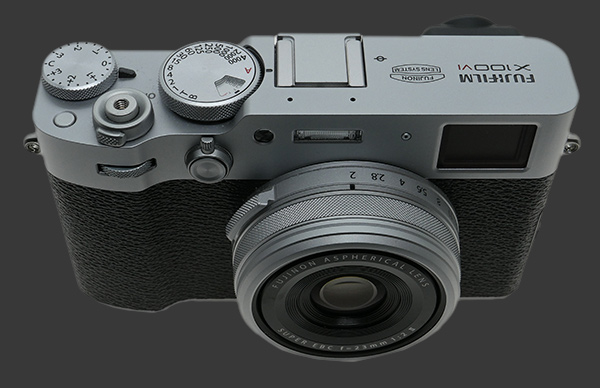
This is a highly specialized digital camera that commands a high price. There are essentially no competitors to the Fujifilm X100VI other than the X100V which is already an excellent camera. The new X100VI manages to increase resolution by 50% and add image-stabilization. These two features alone make an upgrade worth it! And this model adds even more capabilities.
Before considering its image-quality and performance, it is important to consider the fixed 23mm F/2 lens. This is clearly restrictive compared to having a zoom lens or an ILC. At the same time, some users prefer the simplicity. The integrated body of the X100VI allows it be compact and light compared to a similarly-specified mirrorless and lens combination.
Image quality is outstanding. With 40 megapixels, it is possible to make very large prints, up to poster-size. The X-Trans CMOS 5 HR sensor shows low noise between ISO 100-1600 with only a slight reduction in potential print sizes towards the end of that range. Noise picks from there with ISO 6400 showing softness at full-resolution yet with so many pixels it is possible to obtain clear medium-size prints.
Dynamic-range is excellent, only a little less than the X100V that had much larger pixels. Fujifilm color is excellent with so many Film Simulation modes to choose from. Although White-Balance is generally good, it clearly struggles in low light, often leaving a strong yellow tint, even when Auto WB is set to White Priority. This is correctable manually right in the camera though.
Fujifilm used their optics expertise to produce a highly tuned lens that delivers critical sharpness through the frame even wide open. This lens has great contrast, no vignetting and barely any distortion. Flaring is possible yet well-managed. The one thing to fault with the lens - and the only concern for the camera - is that it has a slow focus motor. This prevents it from focusing as quickly as X-series mirrorless cameras with fast glass. Autofocus is reliable and sensitive in low-light. The camera itself is quite responsive and blackout is barely noticeable now.
Ergonomically, the X-series evolved around the rangefinder concept into an efficient digital camera. With a dedicated aperture-ring and dual control-dials, the X100VI rarely slows down the photographer. This model unfortunately has very soft detents on the rear control-dial which lets it turn accidentally. The awkward top-dial that combines Shutter-Speed and ISO, part of its retro look, can be almost entirely bypassed by customizing the camera for a streamlined experience. Besides this, the Drive/Delete button is poorly positioned, while the Q button is smaller than it should be. The Hybrid Viewfinder is a technological marvel that combines a nice EVF with the most sophisticated OVF on the market.
The point of the Fujifilm X100VI is to extract the maximum performance from a fixed 35mm-equivalent lens with a bright aperture. Having now added IBIS, it is possible to use the camera in much lower light than the X100V. Those ready to work with a fixed 46° field-of-view have no better choice than the X100VI.
 |
Please Support Neocamera
All information on Neocamera is provided free of charge yet running this website is a huge endeavor. Purchases made via affiliate links found throughout the site help keep it running and up-to-date. There is no additional cost to you, so please consider buying via these links to our affilates:
Thank you for your support!
Fujifilm X100VI Highlights
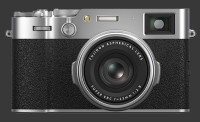
Sensor-Size: 24 x 16mm

Actual size when viewed at 100 DPI
| 40 Megapixels Fixed Lens | ISO 64-51200 |
| Fixed 23mm lens | Shutter 1/180000-900s |
| 5-Axis Built-in Stabilization, 6-Stop Improvement | Full manual controls, including Manual Focus |
| 0.50" Hybrid EVF 3.7 Megapixels (0.66X) | Custom white-balance with 2 axis fine-tuning |
| Automatic Eye-Start sensor | Spot-Metering |
| 1 Axis Digital Level | Hot-Shoe |
| Built-in Dust Reduction | Stereo audio input |
| 13 FPS Drive, 80 Images | Lithium-Ion Battery |
| 6240x3150 @ 30 FPS Video Recording | Secure Digital Extended Capacity |
| 3" LCD 1.6 Megapixels |
Updates
2025.11.13

Best Gifts for Photographers in 2025 by Budget
The annual Neocamera Photography Gift Guide updated to 2025. Find great gifts for photographers with any price budget.
2025.07.07

Stellar Photo Recovery Review
Review of Stellar Photo Recovery V12. This Windows and MacOS software can recover photos and videos in a huge number of formats from memory cards, USB drives, SSDs and HHDs.
2025.05.14

Huion Kamvas 13 Gen 3 Review
In-Depth review of the Huion Kamvas 13 Gen 3 Pen Display Tablet for photographers and graphic artists.
2025.01.18

Fujifilm GFX 2025 Lens Roundup
Lens Review roundup of Fujifilm GFX Medium-Format lenses. Quality, performance and handling of the GF20-35mm F/4R WR, GF30mm F/3.5 Tilt-Shift and the GF55mm F/1.7.
2024.11.18

Best 2024 Photography Gifts for Every Budget
Great gifts for photographers and photo enthusiasts selected for every budget among the best products of 2024.
2024.08.07

Eye Protection Tips for Professional Photographers
The four main considerations for professional photographers regarding eyewear.
2024.07.14

Fujifilm X100VI Review
Flagship fixed-lens compact digital camera with a 40 MP sensor and Image-Stabilization, a first for the series. Retro design featuring dual control-dials, plus direct ISO, Shutter-Speed and EC dials. Its hybrid viewfinder can switch between EVF and OVF mode.
2024.05.09

Fujifilm GFX100 II Review
Flagship 102 Megapixels Medium-Format Mirrorless Digital Camera with 8-Stop 5-Axis IBIS, 8 FPS Drive, 8K Video and 400 MP Super-Resolution capture in a weatherproof and freezeproof body with dual control-dials and dual memory-card slots.
2024.04.03

Fujifilm X-T5 Review
Newest Fujifilm flagship boasting a 40 MP APS-C sensor, 5-axis IBIS with 7-stop efficiency, 15 FPS continuous drive, 6.2K Video capture, dual control-dials and dual SDXC UHS-II slots in a sturdy weatherproof and freezeproof body.
2023.11.20

Best Digital Cameras of 2023
Find out which are the Best Digital Cameras of 2023. All the new Mirrorless Digital Cameras from entry-level to high-end professional.
2023.07.10

Fujifilm X-H2 Review
40 Megapixels APS-C Hybrid Mirrorless Digital Camera with 7-stop IBIS. Fastest shutter ever and 8K video capture. Large builtin EVF with 0.8X magnification and 5.8 MP, plus an Eye-Start Sensor. Packed with features and large number of controls in a weatherproof and freezeproof body.
2023.05.07

Sony FE 20-70mm F/4G Review
Review of the unique Sony FE 20-70mm F/4G lens. The optical zoom of this lens spans ultra-wide-angle and medium focal-length coverage, making it one of the most versatile Full-Frame lenses on the market.













